The tip on Entry and Exit Trajectory – December 2007 spawned a few inquiries on just how wide the entry and exit should be.
The most basic determining factor is speed. The higher the speed, the wider the entry and exit. More later on the speed part.
It is also determined by the type of track you want to skate – offensive, or defensive. An offensive track is one where you are not protecting against a pass and can therefore skate a wider pattern without risk of being passed. A defensive track is one where you are trying to prevent passing and you must change either the entry to a narrow pattern or the exit to a narrow pattern. Or you can skate narrower on both but then you sacrifice maximum speed because it shortens the corner on both ends.
In general, to defend a track, smaller, slower, or less experienced athletes change the exit to skate tighter to the last 3 blocks while keeping the entry a bit wider. Because the speed of a younger athlete is not as high, there is less centrifugal force (CF) pushing them out of the corner and they don’t have to fight as hard to keep the narrower exit trajectory. One common mistake younger athletes make in executing this track pattern is to skate too wide on the entry for the speed they are going, leaving the door open for a pass on the entry, or losing ground because they are covering so much ice.
Older athletes usually let their speed carry them wider out of the exit where there is more CF and then come in closer for the entry where there is less CF. If the entry is done correctly you can actually get a bit of a slingshot effect off the lay in. The biggest mistakes older skaters make on this track pattern is entering too soon and too narrow on the lay in and then letting the exit trajectory drift too wide for the speed they are going.
Starting the entry too wide, too tight, or too early, or finishing the exit too tight or too early also affects the corner lean. We all know the more you lean the more pressure you put in to the ice and the faster you go. Putting yourself in any situation where the lean is compromised means there will be less speed. That’s why it is so critical to nail your entry point on whatever type of track the given situation calls for. If you start the entry too early you can’t lean because you are still essentially on the straightaway. If you start too tight you can’t lean, otherwise you would be inside the blocks right away.
Your entry point and exit point should also match your speed. Let’s take a wide entry / wide exit track for instance. The entry point for a novice skater going 15 seconds per lap is going to be much further down the track and closer to the blocks than for a skater going under 9 seconds per lap. The higher the speed, the more CF you encounter and therefore, the wider your track needs to be. Keep in mind, however, on almost all tracks, you need to be very close to the 3rd, 4th, and 5th blocks.
One common error athletes make is they forget to start making the track narrower as they start to slow down as fatigue sets in. As your speed slows down you gradually have to come narrower as CF is not as great.
The track below gives you an indication how to have your track match your speed for your highest speed. The entry point indicated is where you land your first left to start its push and the exit point is where you land you last left leg to start its push for a wide / wide track using 2 crossovers in to the apex and 2-3 crossovers out of the turn.
If you were to change this track to a defensive exit track you might enter along the green line and exit along the blue line. Or to change it to a defensive (tighter) entry with an offensive (wider) exit you might enter on the blue line and exit on the green line. (See Tracks – January 2005 for a description of various track patterns.)
It is important to keep in mind that your track needs to change depending on the circumstances of the race. If you just skate the same track all the time your opponents will eventually figure out how to get around you.
The most basic determining factor is speed. The higher the speed, the wider the entry and exit. More later on the speed part.
It is also determined by the type of track you want to skate – offensive, or defensive. An offensive track is one where you are not protecting against a pass and can therefore skate a wider pattern without risk of being passed. A defensive track is one where you are trying to prevent passing and you must change either the entry to a narrow pattern or the exit to a narrow pattern. Or you can skate narrower on both but then you sacrifice maximum speed because it shortens the corner on both ends.
In general, to defend a track, smaller, slower, or less experienced athletes change the exit to skate tighter to the last 3 blocks while keeping the entry a bit wider. Because the speed of a younger athlete is not as high, there is less centrifugal force (CF) pushing them out of the corner and they don’t have to fight as hard to keep the narrower exit trajectory. One common mistake younger athletes make in executing this track pattern is to skate too wide on the entry for the speed they are going, leaving the door open for a pass on the entry, or losing ground because they are covering so much ice.
Older athletes usually let their speed carry them wider out of the exit where there is more CF and then come in closer for the entry where there is less CF. If the entry is done correctly you can actually get a bit of a slingshot effect off the lay in. The biggest mistakes older skaters make on this track pattern is entering too soon and too narrow on the lay in and then letting the exit trajectory drift too wide for the speed they are going.
Starting the entry too wide, too tight, or too early, or finishing the exit too tight or too early also affects the corner lean. We all know the more you lean the more pressure you put in to the ice and the faster you go. Putting yourself in any situation where the lean is compromised means there will be less speed. That’s why it is so critical to nail your entry point on whatever type of track the given situation calls for. If you start the entry too early you can’t lean because you are still essentially on the straightaway. If you start too tight you can’t lean, otherwise you would be inside the blocks right away.
Your entry point and exit point should also match your speed. Let’s take a wide entry / wide exit track for instance. The entry point for a novice skater going 15 seconds per lap is going to be much further down the track and closer to the blocks than for a skater going under 9 seconds per lap. The higher the speed, the more CF you encounter and therefore, the wider your track needs to be. Keep in mind, however, on almost all tracks, you need to be very close to the 3rd, 4th, and 5th blocks.
One common error athletes make is they forget to start making the track narrower as they start to slow down as fatigue sets in. As your speed slows down you gradually have to come narrower as CF is not as great.
The track below gives you an indication how to have your track match your speed for your highest speed. The entry point indicated is where you land your first left to start its push and the exit point is where you land you last left leg to start its push for a wide / wide track using 2 crossovers in to the apex and 2-3 crossovers out of the turn.
If you were to change this track to a defensive exit track you might enter along the green line and exit along the blue line. Or to change it to a defensive (tighter) entry with an offensive (wider) exit you might enter on the blue line and exit on the green line. (See Tracks – January 2005 for a description of various track patterns.)
It is important to keep in mind that your track needs to change depending on the circumstances of the race. If you just skate the same track all the time your opponents will eventually figure out how to get around you.


